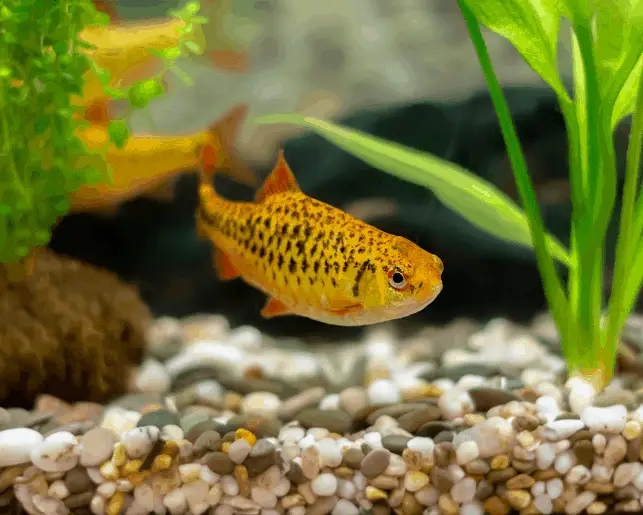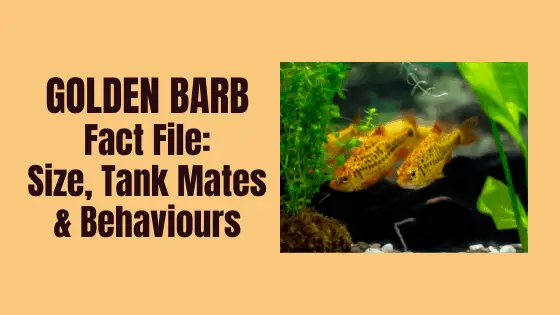The Golden Barb, also known as the Chinese Barb, is a type of cyprinid fish which is native to the Red River Basin in Southeast Asia.
This tropical fish is ideal for a beginner to the hobby as it is a hardy and mostly peaceful fish.

| Name: | Golden Barb |
| Scientific Name: | Barbodes semifasciolatus |
| Family: | Cyprinids |
| Origins: | Southeast Asia |
| Habitat: | Free flowing streams and rivers |
| Adult Length: | 6-8cms |
| Ideal Temp: | 64-78 degrees Fahrenheit |
| Diet: | Omnivore |
| Life Expectancy: | 4-6 years |
| Behaviour & Characteristics: | Mostly peaceful |
| Ideal Tankmates: | Other peaceful species |
| Top, Middle or Bottom: | Middle and bottom |
Scientific Name:
The scientific name for the Gold Barb is Barbodes semifasciolatus.
Scientists have developed a system for naming tropical fish that is called the binomial classification. This way,
a person can be assured they are talking about the same species of fish as somebody from a different country.
Barbodes semifasciolatus is a combination of the Latin words “barbus”, which means barbel, and “semi-fascia“, which means half bands. This name is given to the golden barb due to the banded appearance on their body and face.
Family:
Cyprinidae Family.
Cyprinids are a fish of the carp family, which is the largest family of freshwater fish in the world.
Origins:
The Golden Barb is native to the Red River Basin in Southeast Asia where it is found in China, Vietnam and Southern Thailand. However, the native barbs tend to be a metallic green in colour. The Golden colour Barb has been captive bred since the 1960’s.
Habitat:
The Golden Barb prefers to live in free flowing streams and rivers, surrounded and protected by lots of aquatic plants.
When they do venture out into the open they have been known to form large shoals which fish keepers find fascinating to watch.
Appearance & Size:
The males tend to be smaller than the females. The females are also duller than the males and and have a rounder belly.
Adult Length:
6-8cms. As with all species of fish, this is just a guide as certain conditions can affect the growth of a fish.
Ideal Water Temperature:
64 to 78°F. The Golden Barb likes to be towards the cooler end of warm, and has been known to not actually need a heater in the tank. You would need to make sure any other tankmates can cope with the slightly cooler temperature though.
Diet:
The Golden Barb is an omnivorous fish and will accept all types of food. Flake, live, freeze-dried and vegetarian foods are all accepted by this species. Vegetables such as cucumber or courgette (zucchini for our American friends) are also relished by them as they enjoy having a varied diet whenever possible.
A varied diet helps to keep them healthy and happy. A healthy fish tends to be brighter in colour, as a poor diet can dullen the colour of your fish.
The Golden Barb does not tend to feed from the surface, so it is important to try and get food down as far into the tank as possible. This can be done by using sinking pellets. If you only use floating foods then these will be eaten by the other species of fish before the Golden Barb gets a chance to feed.
Life Expectancy:
The average life expectancy of the Golden Barb is around 4 to 6 years in captivity.
Optimum water quality and diet will help keep them happy into old age.
This is a hardy fish and often makes an ideal first tropical species for beginner aquarists.
Behaviour and Characteristics:
The Golden Barb is a schooling fish so will get along with other species of fish if kept in groups of six or more, and this will make them feel far more secure in their surroundings. If you only have one or two of them, they can become shy and spend the majority of their time hiding at the bottom of the tank, in amongst the plants.
The Golden Barb are one of the calmer species of Barbs, and can have a relaxing effect on their tankmates.
If the water quality of your aquarium is good, then the Golden Barb will most likely have a long life span and actively contribute to the health of your tank. They are a hardy fish that can get along with their own kind as well as other smaller fish, as long as they aren’t so small they look like food.
This species prefers having real or fake plants in the tank for them to hide amongst.
They can be known for fin nipping, although not to the same extent as some of the other Barbs.
The Golden Barb is used to free flowing rivers and streams so would appreciate a tank with a bit of movement in the water.
Compatible Tankmates:
The Golden Barb is a peaceful fish by nature, which means it will get along well with most other species of fish. Peaceful community fish that are large enough not to be seen as food include catfish, loaches and rainbowfish. It also makes an ideal companion for other smaller barbs or livebearers, in order to create a social group.
As with most barbs, the Golden Barb needs to have a certain level of swimming space. This is due to their need for constantly having fresh warm water flowing over their gills for oxygen intake. Being an active swimmer means that they would do best in a tank with live or plastic plants positioned at the bottom section of the aquarium with open space for swimming. Typically, this means having a larger tank to avoid any territorial battles, which can sometimes occur with Barbs.
Top Middle or Bottom swimmer?
Golden Barbs like to occupy both the middle and bottom of the tank. They like to hang out around the bottom of the tank, apart from when they are swimming, when they will actively swim in the middle, so make sure you have space for them to do so.
FINALLY:
As with any fish you are thinking of adding to your tank, please make sure that there is going to be enough space.
You can check on this brilliant AQUARIUM STOCKING CALCULATOR that you have enough room and won’t be overcrowded.
You will need to know the dimensions of your tank, as well as the water capacity for the correct calculation to be made.
Related Posts:
How many barbs can go into a tank?

